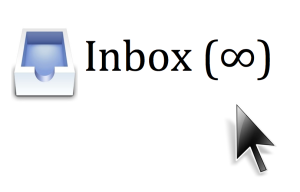 Would you believe the average office worker spends 28% of working hours reading and writing email? If the 2012 McKinsey study is still accurate, and I doubt things have improved, that’s the equivalent of 3 and a 1/3 months each year doing nothing but email!
Would you believe the average office worker spends 28% of working hours reading and writing email? If the 2012 McKinsey study is still accurate, and I doubt things have improved, that’s the equivalent of 3 and a 1/3 months each year doing nothing but email!
Imagine if your company could cut that time in half. What might your employees do with an extra 7 weeks each year? How many more customers could you serve with the same workforce? What would that do to employee stress levels, yours included?
So what are you waiting for?!?! There is no reason to let email consume more than a quarter of your day. Here are 5 steps your company can take to reduce email immediately.
1. Don’t tell people what they need to know.
Instead of telling people what they need to know, tell them what they need to do. And put that at the top of your message!
“I need your input on the Grafton proposal by 10:00 tomorrow. Contact Susan if you haven’t received it. Let me know if you have questions.”
If you absolutely must provide background information or advice, put that after the request. “You might want to keep in mind that …” or “Here is what has been agreed thus far.”
If your email doesn’t leave the reader with a clear next step, your beautifully crafted message will be:
- Ignored and deleted
- Or worse, clog an inbox
- Or worse still, result in a flurry of additional emails
You don’t want to be the author in any of those situations.
2. Don’t copy anyone unless you need something from them.
If you have thought through your needs as a result of #1, you shouldn’t have anyone on the distribution list from whom you need nothing. Even silence should be seen as signifying agreement and support. No one receiving your message should be thinking, “This doesn’t really apply to me.”
3. Stop guessing.
Most email messages are overly complicated and time-consuming because the writer doesn’t know what the reader knows or is thinking. So the writer guesses. Makes assumptions. Or spends precious time trying to anticipate every possible scenario. This is a huge waste of time for both the writer and the readers.
When we talk with someone, we get immediate feedback from our very first statement or question, and we adjust our next words accordingly. Imagine walking up to someone with a long scripted conversation and reading it without making any adjustments based on the reaction you receive. You’d look and sound like an idiot. But no more idiotic than your emails that go on and on without knowing what the other person is thinking.
If you can’t reduce your email to a simple request (e.g., “I need your input on the Grafton proposal by 10:00 tomorrow” or “Read this and then call me to discuss next steps.”), pick up the phone or arrange a time to talk. You’ll save a ton of time, avoid misunderstandings, and develop important cut-to-the-chase skills.
4. Don’t use email if you can’t expect crisp progress in response.
If your email is going to trigger a response more complicated than something like the following, don’t use email:
- Done
- 2:00 Thursday
- Let’s talk
- Yes
- No
- Thank you
- I recommend …
- I’ve decided …
- Only if …
The last thing you want to do is trigger a wandering or philosophical discussion over email.
5. Never use “Reply All.”
Most email messages are sent to too many people to start with. “Reply All” doubles the wasted time. Do your colleagues a favor and leave them off the list.
Impress upon your organization the importance of these five rules and all of you will be spending much less time in your inbox!


Comments are closed.